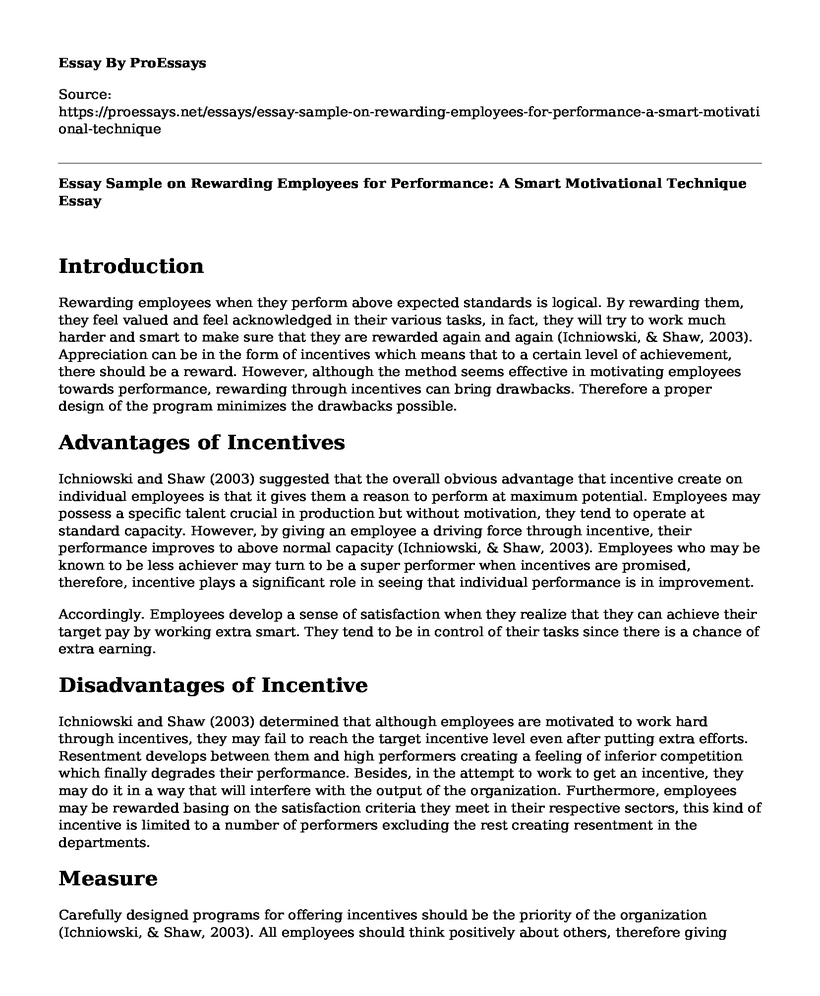Introduction
Rewarding employees when they perform above expected standards is logical. By rewarding them, they feel valued and feel acknowledged in their various tasks, in fact, they will try to work much harder and smart to make sure that they are rewarded again and again (Ichniowski, & Shaw, 2003). Appreciation can be in the form of incentives which means that to a certain level of achievement, there should be a reward. However, although the method seems effective in motivating employees towards performance, rewarding through incentives can bring drawbacks. Therefore a proper design of the program minimizes the drawbacks possible.
Advantages of Incentives
Ichniowski and Shaw (2003) suggested that the overall obvious advantage that incentive create on individual employees is that it gives them a reason to perform at maximum potential. Employees may possess a specific talent crucial in production but without motivation, they tend to operate at standard capacity. However, by giving an employee a driving force through incentive, their performance improves to above normal capacity (Ichniowski, & Shaw, 2003). Employees who may be known to be less achiever may turn to be a super performer when incentives are promised, therefore, incentive plays a significant role in seeing that individual performance is in improvement.
Accordingly. Employees develop a sense of satisfaction when they realize that they can achieve their target pay by working extra smart. They tend to be in control of their tasks since there is a chance of extra earning.
Disadvantages of Incentive
Ichniowski and Shaw (2003) determined that although employees are motivated to work hard through incentives, they may fail to reach the target incentive level even after putting extra efforts. Resentment develops between them and high performers creating a feeling of inferior competition which finally degrades their performance. Besides, in the attempt to work to get an incentive, they may do it in a way that will interfere with the output of the organization. Furthermore, employees may be rewarded basing on the satisfaction criteria they meet in their respective sectors, this kind of incentive is limited to a number of performers excluding the rest creating resentment in the departments.
Measure
Carefully designed programs for offering incentives should be the priority of the organization (Ichniowski, & Shaw, 2003). All employees should think positively about others, therefore giving incentives with equality is critical. Rewarding every department equally without considering the position they hold is effective in seeing that resentment is minimized.
Reference
Ichniowski, C., & Shaw, K. (2003). Beyond incentive pay: Insiders' estimates of the value of complementary human resource management practices. Journal of Economic Perspectives, 17(1), 155-180. Retrieved from https://www.aeaweb.org/articles?id=10.1257/089533003321164994
Cite this page
Essay Sample on Rewarding Employees for Performance: A Smart Motivational Technique. (2023, Apr 10). Retrieved from https://proessays.net/essays/essay-sample-on-rewarding-employees-for-performance-a-smart-motivational-technique
If you are the original author of this essay and no longer wish to have it published on the ProEssays website, please click below to request its removal:
- Working In the Interior Ministry - Admission Essay
- The Human Resource Problem of Stagecoach Group Case Study
- The Characteristics of Expert Teachers Paper Example
- Essay Example on FMLA: Balancing Family and Work Responsibilities
- Essay Sample on Sweatshops: Poor Wages, Unhealthy Conditions, and the Closing of Russell Corporation
- Paper Example on Reforming Complaints Processes: Involving HR for Positive Outcomes
- Essay Sample on Managing Work Stress: Exploring the Stress Model in the Workplace







